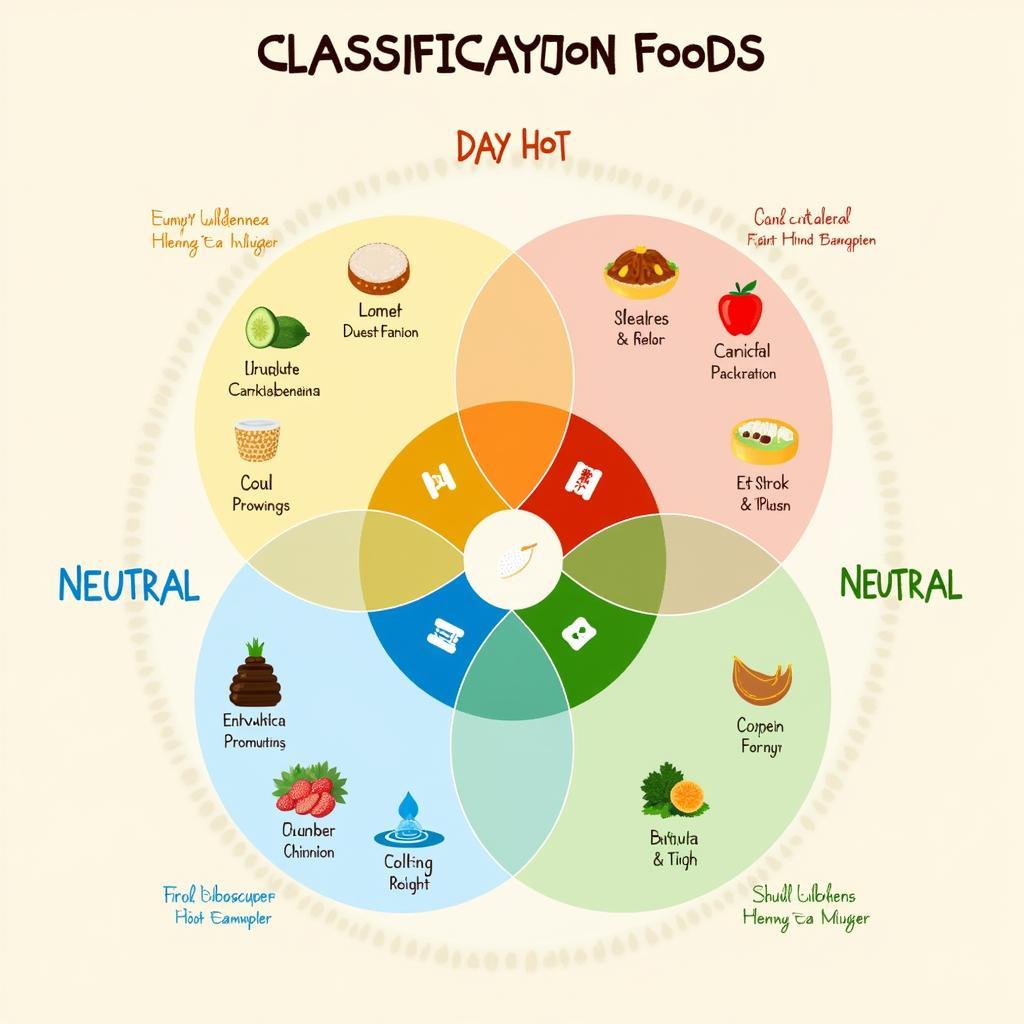Understanding the Chinese Hot And Cold Foods Chart is crucial for anyone interested in Traditional Chinese Medicine (TCM) and its approach to diet. This chart isn’t about actual temperature, but rather the energetic properties of food and their effects on the body. This ancient practice classifies foods as “hot,” “cold,” or “neutral” to maintain balance and harmony within the body. We’ll delve into this fascinating concept, exploring its principles, providing a comprehensive Chinese hot and cold foods chart, and discussing how you can incorporate it into your daily life. chinese ‘hot and cold foods chart helps you to maintain a healthy balance in your body.
Understanding the Principles of Yin and Yang in Food
The Chinese hot and cold foods chart is rooted in the ancient philosophy of Yin and Yang. Yin represents cold, dark, and passive energy, while Yang represents hot, bright, and active energy. TCM aims to balance these opposing forces within the body, believing that imbalance leads to illness. Foods are categorized based on their perceived energetic effects. “Hot” foods are believed to increase Yang energy, while “cold” foods increase Yin energy. “Neutral” foods have a balanced effect on both.
Exploring the Chinese Hot and Cold Foods Chart
What exactly constitutes a “hot” or “cold” food? The Chinese hot and cold foods chart categorizes a wide range of ingredients. Generally, “hot” foods are often spicy, cooked, or red in color, such as ginger, chili peppers, and lamb. “Cold” foods are often raw, watery, or green, like cucumbers, watermelon, and mint. It’s important to remember that this classification is not absolute. The cooking method and preparation can also influence a food’s energetic properties. For example, raw ginger is considered warming, while pickled ginger is cooling.
 Chinese Hot and Cold Foods Chart Illustration
Chinese Hot and Cold Foods Chart Illustration
How to Use the Chinese Hot and Cold Foods Chart in Your Daily Life
Integrating the principles of the Chinese hot and cold foods chart into your diet doesn’t require drastic changes. It’s about mindful eating and balance. Consider your individual constitution and the prevailing climate. If you tend to feel cold, incorporate more “warming” foods. Conversely, if you often feel hot, favor “cooling” foods. During winter, emphasize warming dishes like soups and stews. In summer, opt for lighter, cooling meals with fresh fruits and vegetables. yin yang food chart provides insight into choosing foods that balance your body’s energy.
What are some examples of hot foods?
Common hot foods include ginger, garlic, cinnamon, and lamb.
What are some examples of cold foods?
Typical cold foods include watermelon, cucumber, mint, and tofu.
Benefits of Balancing Your Diet with the Chinese Hot and Cold Foods Chart
The Chinese hot and cold foods chart is not a rigid diet plan but a framework for creating a balanced diet. By incorporating its principles, you can potentially improve digestion, boost energy levels, and enhance overall well-being. yin and yang food chart helps you to learn about the potential benefits of a balanced diet.
“In my practice, I often see patients benefit from incorporating the principles of the Chinese hot and cold foods chart,” says Dr. Mei Lin, a renowned practitioner of Traditional Chinese Medicine. “It’s a powerful tool for promoting balance and harmony within the body.”
Addressing Common Misconceptions About the Chinese Hot and Cold Foods Chart
One common misconception is that the “hot” and “cold” designations refer to the actual temperature of the food. As we’ve discussed, these terms refer to the food’s energetic properties. Another misconception is that this approach is a strict diet. It’s not about eliminating certain foods but rather about creating balance.
Is the Chinese hot and cold foods chart scientifically proven?
While the Chinese hot and cold foods chart is deeply rooted in traditional practice, scientific research is still exploring its mechanisms and benefits.
Can I still enjoy my favorite foods while following this approach?
Absolutely! The key is moderation and balance. chinese medicine warming foods offer a variety of delicious options for colder days.
In conclusion, the Chinese hot and cold foods chart is a valuable tool for understanding the energetic properties of food and their effects on the body. By incorporating its principles, you can strive for a more balanced and harmonious diet. Remember, this approach isn’t about strict rules, but rather mindful eating and finding what works best for your individual needs. The Chinese hot and cold foods chart can guide you towards a healthier and more balanced approach to eating. hot and cold foods list provides a detailed breakdown to guide your choices.
FAQ
- What is the Chinese hot and cold foods chart based on? (Traditional Chinese Medicine principles of Yin and Yang)
- Does the chart refer to the actual temperature of the food? (No, it refers to the food’s energetic properties.)
- What are examples of “hot” foods? (Ginger, garlic, chili peppers)
- What are examples of “cold” foods? (Watermelon, cucumber, mint)
- Is this a strict diet? (No, it’s about balance and moderation.)
- How can I incorporate this chart into my life? (Consider your individual constitution and the climate.)
- What are the potential benefits? (Improved digestion, increased energy, enhanced well-being)
For further assistance, please contact us at Phone Number: 02437655121, Email: minacones@gmail.com or visit our address: 3PGH+8R9, ĐT70A, thôn Trung, Bắc Từ Liêm, Hà Nội, Việt Nam. We have a 24/7 customer service team.